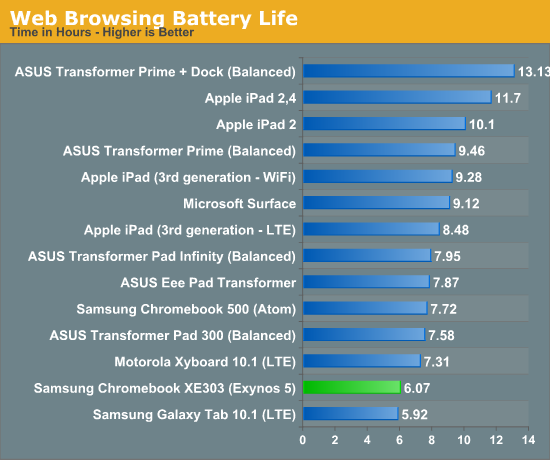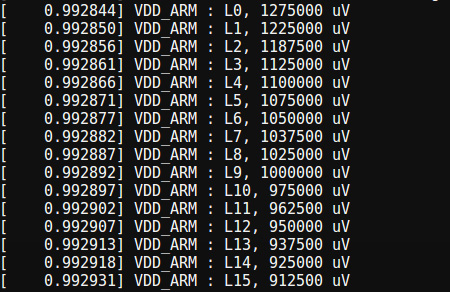Samsung Chromebook (XE303) Review: Testing ARM's Cortex A15
by Anand Lal Shimpi on October 31, 2012 9:00 AM ESTBattery Life & Power Analysis
The final unknown in all of this is power consumption. ARM's Cortex A15 isn't really supposed to be a sipper of power, and when placed in a notebook I don't know that there's a lot we can conclude about how it stacks up to Atom either. Some high level power consumption data would normally help but these two platforms are fairly different:
| Samsung Chromebook Power Consumption Comparison | ||||||
| Display @ 200 nits | Idle | Kraken (Avg) | Kraken (Peak) | |||
| Samsung Chromebook 500 (Atom N570) | 11.53W | 14.4W | 15.2W | |||
| Samsung Chromebook 303 (Exynos 5 Dual) | 6.33W | 10.5W | 11.3W | |||
The new Chromebook consumes considerably less power at idle than its predecessor. The smaller display, simplified motherboard and truly integrated SoC platform are likely all to thank for this. The significant reduction in power also helps explain the big reduction in battery capacity as well.
Under load, the two platforms do see differing levels of additional power consumption. The new Exynos 5 based Chromebook sees a dramatic increase in power consumption under load, hitting 10.5W (a 66% increase over idle) while running Mozilla's Kraken benchmark. The Atom N570 based Chromebook increases power consumption as well, but just not by as significant a degree: ~25%. This actually helps illustrate exactly why Atom wasn't phone worthy in its earlier incarnations. Contrary to popular belief, it wasn't actually peak power consumption that was the problem (a move to 32nm can easily eat into these numbers). The total platform power consumption, particularly at idle, was Atom's real problem in the early days. It also turns out that this is much of what keeps Intel's Core processors from moving into ultra mobile form factors, something that Haswell is supposed to address.
Given that we're dealing with somewhat different panels here, I wanted to see what power consumption looked like if we removed the panels from the equations. I re-ran all of the power data with the display turned off:
| Samsung Chromebook Power Consumption Comparison | ||||||
| Display Off | Idle | Kraken (Avg) | Kraken (Peak) | |||
| Samsung Chromebook 500 (Atom N570) | 8.82W | 11.4W | 12.4W | |||
| Samsung Chromebook 303 (Exynos 5 Dual) | 4.07W | 8.32W | 9.27W | |||
The old Atom based Chromebook uses more than twice the idle power of the new version - it's no wonder Google was able to get away with a battery half the size. Once again however we see a much larger increase in power consumption once the Cortex A15 is under heavy load. Active power consumption more than doubles on the new Chromebook, while we see around a 30% increase on the Atom based system. I do wonder what will have to be done to get the Exynos 5 Dual into a smartphone as an increase of ~4W under load just won't cut it in a phone. The Atom platform shows a 2.6W increase in power under load, which sounds about right for a high clocked 45nm part.

Despite the more power efficient platform, the reduction in battery capacity puts the new Chromebook well below the Atom model in battery life. Our wireless web browsing test put the new Chromebook at just over 6 hours of continuous use on a single charge. For a notebook that's not too bad, but compared to modern tablets it's not good.

The performance gains over Atom (and by extension, the ARM Cortex A9) do give us some indication as to what could be done to get Exynos 5 into a smartphone. By dropping clocks much lower than 1.7GHz Samsung would be able to maintain a performance advantage in a very power constrained device and hopefully keep power in check. The photo above features a list of all of the voltage levels supported by Samsung's Exynos 5 Dual as implemented in the new Chromebook.










149 Comments
View All Comments
Krysto - Thursday, November 1, 2012 - link
Tablets and phones don't boot-up instantaneously. That's waking from idle mode that you're talking about, which basically just means turning on the screen.Krysto - Wednesday, October 31, 2012 - link
When Cortex A7 arrives in big.Little I expect the idle times to drop dramatically in A15 set-ups, and I doubt Intel can keep up with that. Not to mention they still won't keep up in graphics department.Anand, can you stop plugging Surface into Android and Chromebook reviews? Why would I want to hear how Surface might do in the future with this chip that Chromebook already has? Seriously.
Exophase - Wednesday, October 31, 2012 - link
Anand's Cortex-A15 diagram looks really weird vs an official one.. http://regmedia.co.uk/2011/10/20/arm_a15_pipeline_...Three instructions are decoded and dispatched to 5 clusters of 8 execution queues (8 slots each) per cycle, then each cycle each execution queue can issue a cycle to its associated execution unit (note this diagram is using issue/dispatch opposite from how it's often used). There's no execution relationship like given in Anand's diagram, the clusters are: NEON (2x), load/store (2x), simple ALU (2x), multiply, and branch.
Anand Lal Shimpi - Wednesday, October 31, 2012 - link
I based my diagram on a lot of the content in here:http://www.arm.com/files/pdf/AT-Exploring_the_Desi...
Slide 20 introduces the independent issue queues, although subsequent slides make it all a bit more ambiguous (and more like the block diagram you included). I didn't include "issue" width for each of the arrows in my diagram to keep thing simple but I can see that it can definitely give the wrong impression.
Let me see about doing a better pass on the A15 once I'm back from my current trip.
Take care,
Anand
madmilk - Wednesday, October 31, 2012 - link
More proof that ARM ISA isn't magically more efficient than x86 in perf/watt.My i7-3720QM Mac can complete Kraken in 2100ms, with a load power consumption of 30W and idle power of 12W (display on at mid-brightness, discrete GPU off). Ivy has very good power gating, so I'll just assume the CPU is consuming 20W. This results in 42 Joules to complete one run of Kraken. The A15 on the other hand, with a differential of 4 watts (again assuming perfect gating at idle) takes 38.8 Joules. In server usage, perf/watt is king. If the best ARM can deliver is 10% better perf/watt at the expense of 5x per-core performance, they're not going to make a dent against Xeon. I imagine V8 could be optimized more for ARM, but the gains there are not nearly as big as before.
Some other observations -
I ran 8 instances of Kraken at once to make use of all the cores and HT, while reducing the effect of perf/watt-killing Turbo Boost. Power consumption was about 65W total, or approximately 55W going into the CPU. Each Kraken finished in about 3700ms, so what we have is 55W*3.7s/8 = 25 joules per Kraken. Much better, but obviously an apples-to-oranges comparison against the A15 which should probably have two instances run on it for optimal efficiency.
Also, shame on Intel/Samsung/Google for the Chromebook 500. 12W idling for a netbook is just ridiculous.
I don't think we can pull the 32nm vs 22nm fab card here either, because Intel has always been ahead in this respect and the gap is widening.
lemonadesoda - Wednesday, October 31, 2012 - link
The new chromebook is a near-winner! While it is targetting impulse purchase, low-budget buyers, and 2nd world economies, they should consider a 1st world premium buyer audience. If this had a better quality screen with "retina" pixel density, I would buy one in a heartbeat. I don't want to game... I want to read my PDFs without having to zoom to make the text legible... and with the SD card reader... it would be a perfect image display device for the SD cards once it comes out of the camera. 1366x768 is very 2009, not 2012.ol1bit - Wednesday, October 31, 2012 - link
I don't understand why Chrome OS continues at all?Just slapping JellyBean on this hardware would have much more functionality.
andrewaggb - Wednesday, October 31, 2012 - link
Only google can answer this question....Kinda like Firefox OS... or whatever they are calling it. Just not sure what the point is. Maybe they figured linux needs just a few more radically different distributions :-)
ssddaydream - Wednesday, October 31, 2012 - link
Please, will somebody ban this clown?ShaneMickey, that is...
ssddaydream - Thursday, November 1, 2012 - link
...there will be support that would allow AndroidOS, Linux, or Windows RT to be installed and properly functioning on this device.